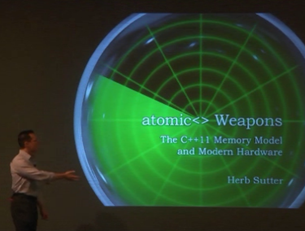[ETA: Updated OneDrive slides link]
 Most of the talks I gave at C++ and Beyond 2012 last summer are already online at Channel 9. Here are two more.
Most of the talks I gave at C++ and Beyond 2012 last summer are already online at Channel 9. Here are two more.
This is a two-part talk that covers the C++ memory model, how locks and atomics and fences interact and map to hardware, and more. Even though we’re talking about C++, much of this is also applicable to Java and .NET which have similar memory models, but not all the features of C++ (such as relaxed atomics).
Note: This is about the basic structure and tools, not how to write lock-free algorithms using atomics. That next-level topic may be on deck for this year’s C++ and Beyond in December, we’ll see…
atomic<> Weapons: The C++ Memory Model and Modern Hardware
- Part 1: Optimizations, races, and the memory model; acquire and release ordering; mutexes vs. atomics vs. fences
- Part 2: Restrictions on compilers and hardware (incl. common bugs); code generation and performance on x86/x64, IA64, POWER, ARM, and more; relaxed atomics; volatile
This session in one word: Deep.
It’s a session that includes topics I’ve publicly said for years is Stuff You Shouldn’t Need To Know and I Just Won’t Teach, but it’s becoming achingly clear that people do need to know about it. Achingly, heartbreakingly clear, because some hardware incents you to pull out the big guns to achieve top performance, and C++ programmers just are so addicted to full performance that they’ll reach for the big red levers with the flashing warning lights. Since we can’t keep people from pulling the big red levers, we’d better document the A to Z of what the levers actually do, so that people don’t SCRAM unless they really, really, really meant to.
Topics Covered:
- The facts: The C++11 memory model and what it requires you to do to make sure your code is correct and stays correct. We’ll include clear answers to several FAQs: “how do the compiler and hardware cooperate to remember how to respect these rules?”, “what is a race condition?”, and the ageless one-hand-clapping question “how is a race condition like a debugger?”
- The tools: The deep interrelationships and fundamental tradeoffs among mutexes, atomics, and fences/barriers. I’ll try to convince you why standalone memory barriers are bad, and why barriers should always be associated with a specific load or store.
- The unspeakables: I’ll grudgingly and reluctantly talk about the Thing I Said I’d Never Teach That Programmers Should Never Need To Now: relaxed atomics. Don’t use them! If you can avoid it. But here’s what you need to know, even though it would be nice if you didn’t need to know it.
- The rapidly-changing hardware reality: How locks and atomics map to hardware instructions on ARM and x86/x64, and throw in POWER and Itanium for good measure – and I’ll cover how and why the answers are actually different last year and this year, and how they will likely be different again a few years from now. We’ll cover how the latest CPU and GPU hardware memory models are rapidly evolving, and how this directly affects C++ programmers.